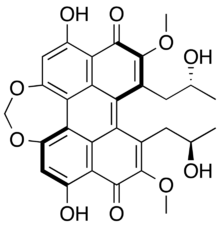Chemistry:Cercosporin

| |
| Names | |
|---|---|
| IUPAC name
7,19-dihydroxy-5,21-bis(2-hydroxypropyl)-6,20-dimethoxy-12,14-dioxahexacyclo[13.8.0.02,11.03,8.04,22.018,23]tricosa-1,3(8),4,6,10,15,18(23),19,21-nonaene-9,17-dione
| |
| Identifiers | |
3D model (JSmol)
|
|
| ChEBI | |
| ChEMBL | |
| ChemSpider | |
PubChem CID
|
|
| UNII | |
| |
| |
| Properties | |
| C29H26O10 | |
| Molar mass | 534.517 g·mol−1 |
Except where otherwise noted, data are given for materials in their standard state (at 25 °C [77 °F], 100 kPa). | |
| Infobox references | |
Cercosporin is a red toxin created by the fungal genus Cercospora. Cercospora act as pathogens on a variety of plants including corn, tobacco, soybean, and coffee.[1] Cercosporin is a perylenequinone natural product[2][3] that is photoactivated and uses reactive oxygen species (ROS) to damage cell components (membranes, proteins, lipids, etc.).[4]
Biosynthesis
Light is required for biosynthesis and activation of cercosporin, and it has been demonstrated that light, temperature, and culture medium are regulating factors in the production of cercosporin.[5]
Cercosporin is biosynthesized via polyketide synthases, and there are several genes that have been found responsible in the creation of the natural product.[4][6] Overall, there are 8 CTB enzymes (CTB1-8) that contribute to the production of cercosporin.[4] CTB1 (cercosporin toxin biosynthesis) is a non-reducing PKS consisting of a KS, AT, TE/CYC and 2 ACP domains that are vital in the initiation of the creation of cercosporin.[6] The other CTB enzymes are not as well studied, but play important roles in the biosynthesis. CTB2 acts as a methyl transferase, CTB3 also functions as a methyl transferase but also functions as a FAD-dependent monoxygenase, CTB4 is a MFS transporter, CTB5 is a FAD-dependent oxidoreductase, CTB6 is a NADPH-dependent ketone reductase, CTB7 is another FAD-dependent monoxygenase, and CTB8 is a transcription factor that regulates expression of the cluster.[4][7] Figure 1 shows a general depiction of the proposed biosynthesis. As a result of the two hydroxypropyl substituents and the two oxygen substituents of the acetal linker, the perylene core twists out of planarity. The natural product occurs as a single atropisomer.[4]

Plant defense and susceptibility
To combat the onset of disease caused by Cercospora fungi, it has been proven that growing plants in lower light intensities can reduce the amount and severity of lesions caused by cercosporin.[1][8] Some plant species use chitinases as a general defense mechanism to stop fungal infections.[9] It has been observed that cercosporin-producing fungi that contain the Avr4 gene produce an effector that acts as a chitin-binding protein, allowing the fungi to be more virulent.[9]
References
- ↑ 1.0 1.1 "Photoactivated perylenequinone toxins in fungal pathogenesis of plants". FEMS Microbiology Letters 252 (2): 197–206. November 2005. doi:10.1016/j.femsle.2005.08.033. PMID 16165316.
- ↑ Kuyama, Shimpei; Tamura, Teiichi (1957). "Cercosporin. A Pigment of Cercosporina Kikuchii Matsumoto et Tomoyasu. I. Cultivation of Fungus, Isolation and Purification of Pigment". J. Am. Chem. Soc. 79 (21): 5725–5726. doi:10.1021/ja01578a038.
- ↑ Kuyama, Shimpei; Tamura, Teiichi (1957). "Cercosporin. A Pigment of Cercosporina Kikuchii Matsumoto et Tomoyasu. II. Physical and Chemical Properties of Cercosporin and its Derivatives". J. Am. Chem. Soc. 79 (21): 5726–5729. doi:10.1021/ja01578a039.
- ↑ 4.0 4.1 4.2 4.3 4.4 4.5 "Molecular Characterization of the Cercosporin Biosynthetic Pathway in the Fungal Plant Pathogen Cercospora nicotianae". Journal of the American Chemical Society 138 (12): 4219–4228. March 2016. doi:10.1021/jacs.6b00633. PMID 26938470.
- ↑ "Regulation of Cercosporin Accumulation in Culture by Medium and Temperature Manipulation". Phytopathology 79 (2): 213–219. 1989. doi:10.1094/Phyto-79-213. https://www.apsnet.org/publications/phytopathology/backissues/Documents/1989Articles/Phyto79n02_213.PDF.
- ↑ 6.0 6.1 "The CTB1 gene encoding a fungal polyketide synthase is required for cercosporin biosynthesis and fungal virulence of Cercospora nicotianae". Molecular Plant-Microbe Interactions 18 (5): 468–476. May 2005. doi:10.1094/mpmi-18-0468. PMID 15915645.
- ↑ "Molecular analysis of the cercosporin biosynthetic gene cluster in Cercospora nicotianae". Molecular Microbiology 64 (3): 755–770. May 2007. doi:10.1111/j.1365-2958.2007.05689.x. PMID 17462021.
- ↑ "Symptoms of Cercospora leaf spot of sugar beets influenced by light intensity.". Phytopathology 57: 799–800. 1967.
- ↑ 9.0 9.1 "The AVR4 effector is involved in cercosporin biosynthesis and likely affects the virulence of Cercospora cf. flagellaris on soybean". Molecular Plant Pathology 21 (1): 53–65. January 2020. doi:10.1111/mpp.12879. PMID 31642594.
 |

